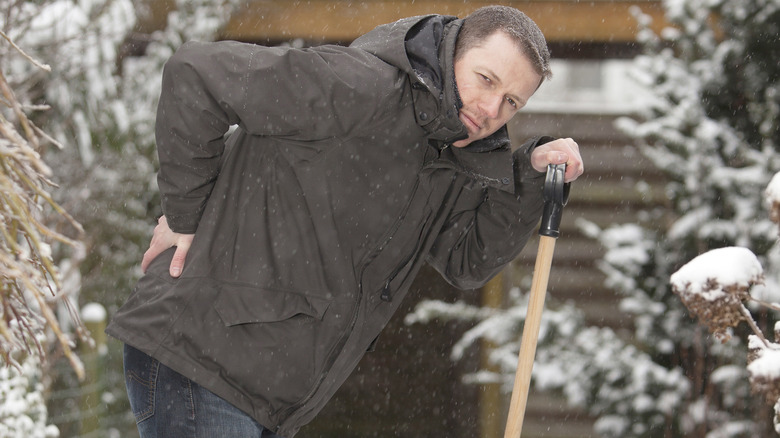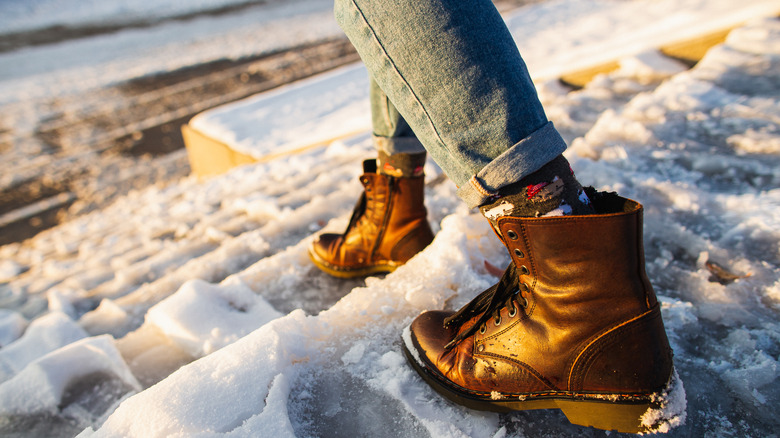An Orthopedic Surgeon's Top Tips For Preventing Common Wintertime Injuries
Every year, as wintertime approaches, many of us retreat indoors to escape the bitter cold. At some point, however, we must leave the comfort of our cozy spot by the fireside and venture outdoors. Whether it's to run errands or shovel your driveway now buried in snow, such wintertime activities can heighten our risk for injuries. In an interview, Health Digest spoke with Arnoldas Sipavicius, an orthopedic surgeon at Nordorthopaedics Clinic, which is a leading international orthopedic center in Kaunas, Lithuania. He shared his top tips for how best to protect ourselves from injury during the winter months.
Dr. Sipavicius starts off by highlighting the three most common causes of injury seen throughout the winter season. "Falling down after slipping on the icy or snowy pavement" is the first most common cause of injury, he states. "The injuries affect the lower extremities, like ankles or knees, and the upper extremities, like wrists, elbows, and shoulders."
He goes on to state how these injuries can take many forms, such as head trauma, amongst others. "They may cause ligament sprains or tears, ankle and calf fractures, contusions, ligament traumas, and fractures of the distal radius, distal humerus, ulnar head, or radial head."
Tips for avoiding injuries
Another common cause of injury during the winter is incorrect snow shoveling, Dr. Sipavicius tells Health Digest. "The injuries resulting from holding the shovel the wrong way may range from back strains to issues with the spinal disc," he states. But that's not all.
While many of us may enjoy skiing, sledding, or ice skating during the colder months of the year, Dr. Sipavicius points out that accidents are also common among those who engage in winter sports. "The most common injuries are bone fractures, strains, dislocations, and sprains," he explains.
To help protect ourselves from injury, Dr. Sipavicius emphasizes the importance of awareness of weather conditions. "In order to prevent winter-related injuries mentioned above, people should assess the weather and pavement conditions and avoid unnecessary travels and going out if there's ice and the streets are slippery," he says.
If you must go out, dressing and moving appropriately is key. "Proper footwear is important, as is walking slowly, distributing the body balance so as not to fall backward, and putting on thick headwear so that it protects during a fall."
In the event of a fall, Dr. Sipavicius encourages individuals to have their hands at the ready. "People should not walk with their hands in their pockets even if it is very cold outside, because then they can better protect their heads and other parts when falling down."
What to do if you experience an injury
If you do experience an injury, Dr. Sipavicius shares what to do in the immediate aftermath. "If a person sustains an injury, they should protect the injured part from repeated trauma by immobilizing it, put some ice on it, elevate it at the heart level and above, or wear an elastic bandage for edema control," he advises. He explains that mild injuries can be treated using at-home remedies, such as the PRICE method, which stands for Protect, Rest, Ice, Compression, and Elevation.
However, more serious injuries will require medical attention. "If the pain is severe and increases, and there is a visible deformation, swelling, or increasing hemorrhaging, they should immediately contact the urgent care facility and consult a specialist," Dr. Sipavicius states.
"Since untreated injuries like fractures or ligament traumas may limit mobility, increase the risk of complications, and impair the post-treatment result, in case[s] of more severe traumas, people might need X-ray examinations, and specialized diagnostics to determine the diagnosis or choose a treatment plan," Dr. Sipavicius concludes.
Connect with Nordorthopaedics Clinic on Facebook.



